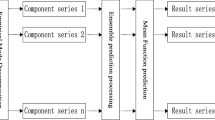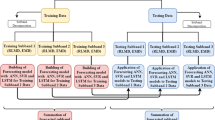Abstract
To predict the most suitable mode decomposition technique for machine learning in meteorological time series prediction, this study has been carried out. The best mode decomposition technique along with a suitable machine learning algorithm will help predict a time series accurately. For this empirical mode decomposition (EMD), ensemble empirical mode decomposition (EEMD), coupled ensemble EMD with adaptive noise (CEEMDAN), variational mode decomposition (VMD), singular spectrum analysis (SSA) and independent component analysis (ICA) have been taken for comparison. The long short-term memory (LSTM) network has been used for machine learning. The max–min temperature time series have been constructed from Kolkata's max–min temperature data. Those time series have been predicted individually by the LSTM network along with each of these techniques. It has been found that the predicted time series by LSTM decomposed by ICA mostly matches the original time series compared to other techniques.




































Similar content being viewed by others
References
Abdel-Aal R E 2004 Hourly temperature forecasting using abductive networks; Eng. Appl. Artif. Intell. 17 543–556.
Al-Dahidi S, Ayadi O, Adeeb J, Alrbai M and Qwasmeh B R 2018 Extreme learning machines for solar photovoltaic power predictions; Energies 11 2725.
Alzahrani A, Kimball J W and Dagli C 2014 Predicting solar irradiance using time series neural networks; Proc. Comput. Sci. 36(c) 623–628.
Beltrán-Castro J, Valencia-Aguirre J, Orozco-Alzate M, Castellanos-Domínguez G and Travieso-González C M2013 Rainfall forecasting based on ensemble empirical mode decomposition and neural networks; In: Advances in Computational Intelligence (eds) Rojas I, Joya G and Gabestany J, IWANN, Lecture Notes in Computer Science, vol. 7902, Springer, Berlin, Heidelberg.
Chen M-H 2016 A quantile regression analysis of tourism market growth effect on the hotel industry; Int. J. Hospital. Manage. 52 117–120.
Dash Y, Mishra S K and Panigrahi B K 2017 Rainfall prediction of maritime state (Kerala), India using SLFN and ELM techniques; Proceedings of the 2017 International Conference on Intelligence Computing, Instrumentation and Control Technologies (ICICICT), Kannur, India, 6–7 July 2017, pp. 1714–1718.
Dragomiretskiy K and Zosso D 2014 Variational mode decomposition; IEEE Trans. Signal Process. 62(3) 531–544.
Gao Y-F, Liang Y-S, Liu Y, Zhan S-B and Ou Z-W 2009 A neural network based forecasting algorithm for retail industry; Proceedings of the eighth international conference on machine learning and cybernetics, Baoding, 12–15 July, 2009, https://doi.org/10.1109/ICMLC.2009.5212392.
Huang N E, Shen Z, Long S R, Wu M C, Shih H H, Zheng Q, Yen N-C, Tung C C and Liu H H 1998 The empirical mode decomposition and the Hilbert spectrum for nonlinear and nonstationary time-series analysis; Proc. Roy. Soc. London A 454 903–995.
Jahirul M I, Brown R J, Senadeera W, O’Hara I M and Ristovski Z D 2013 The use of artificial neural networks for identifying biodiesel feedstocks; Energies 6 3764–3806.
Liang H, Bressler S L, Buffalo E A, Desimone R and Fries P 2005 Empirical mode decomposition of field potentials from macaque V4 in visual spatial attention; Biol. Cybern. 92 380–392.
Marović I, Susanj I and Ozanic N 2017 Development of ANN model for wind speed prediction as a support for early warning system; Complexity 2017 3418145, https://doi.org/10.1155/2017/3418145.
Mislan H, Hardwinarto S and Sumaryono M A 2015 Rainfall monthly prediction based on artificial neural network: A case study in Tenggarong station, East Kalimantan, Indonesia; Proc. Comput. Sci. 59 142–151.
Naskar P R and Naskar S 2022 A new neurocomputing approach for medium-range temperature prediction; Mausam 73(3) 537–554, https://doi.org/10.54302/mausam.v73i3.5931.
Newell K M, Liu Y T and Mayer-Kress G 2001 Time scales in motor learning development; Psychol. Rev. 108 57–82.
Paniagua-Tineo A, Salcedo-Sanz S, Casanova-Mateo C, Ortiz-García E G, Cony M A and Hernández-Martín E 2011 Prediction of daily maximum temperature using a support vector regression algorithm; Renew. Energ. 36 3054–3060.
Patil K, Deo M C and Ravichandran M 2016 Prediction of sea surface temperature by combining numerical and neural techniques; J. Atmos. Oceanic Technol. 33 1715–1726.
Poornima S and Pushpalata M 2019 Prediction of rainfall using intensified LSTM based recurrent neural network with weighted linear units; Atmosphere 10 668, https://doi.org/10.3390/atmos10110668.
Qasem M H and Nemer L 2020 Extreme learning machine for credit risk analysis; J. Intell. Syst. 29(1) 640–652.
Salcedo-Sanz S, Casanova-Mateo C, Pastor-Sánchez A and Sánchez-Girón 2014 Daily Global solar radiation prediction based on a hybrid coral reefs optimisation-extreme learning machine approach; Solar Energy 105 91–98.
Shrivastava N A, Panigrahi B K and Lim M-H 2014 Electricity price classification using extreme learning machines; Neural. Comput. Appl., https://doi.org/10.1007/s00521-013-1537-1.
Singh M, Krishnan R, Goswami B, Choudhuri A D, Swapna P, Vellore R, Prajeesh A G, Sandeep N, Venkatraman C, Donner R V, Marwan N and Kurths J 2020 Fingerprint of volcanic forcing on the Enso-Indian monsoon coupling; Sci. Adv. 6 eaba8164, https://doi.org/10.1126/sciadv.aba8164.
Sinha A, Kathayat G, Cheng H, Breitenbach S F M, Berkelhammer M, Mudelsee M, Biswas J and Edwards R L 2015 Trends and oscillations in the Indian summer monsoon rainfall over the last two millennia; Nat. Commun. 6 6309, https://doi.org/10.1038/ncomms7309.
Smith B A, Hoogenboom G and McClendon R W 2007 Improving air temperature prediction with artificial neural networks; Int. J. Comput. Intell. 3(3) 179–186.
Torres M E, Colomias M A, Schlotthauer G and Flandrin P 2011 A complete ensemble empirical mode decomposition with adaptive noise; ICASSP 2011.
Wang P-H, Lin G-H and Wang Y-C 2019 Application of neural networks to explore manufacturing sales prediction; Appl. Sci. 9 5107.
Youn-Jung Son R N, Hong-Gee K, Eung-Hee Kim M E, Choi S and Soo-Kyoung Lee R N 2010 Application of support vector machine for prediction of medication adherence in heart failure patients; Health. Inform. Res. 16(4) 253–259.
Zhang H-C and Huang S-H 1995 Applications of neural networks in manufacturing: A state-of-the-art survey; Int. J. Product. Res. 33(3) 705–728.
Zhang Y, Pan G, Chen B, Han J, Zhao Y and Zhang C 2020 Short-term wind speed prediction model based on GA-ANN improved by VMD; Renew. Energ. 156 1373–1388.
Zhang Z and Dong Y 2020 Temperature forecasting via convolution recurrent neural networks based on the time series data; Complexity 2020 3536572.
Zou Y, Zhao X, Chu Y, Xu W, Han J and Li W 2022 A supervised independent component analysis algorithm for motion imagery-based brain computer interface; Biomed. Signal Process. Control 75 103576, https://doi.org/10.1016/j.bspc.2022.103576.
Acknowledgements
We gratefully acknowledge India Meteorological Department for encouraging and supplying us with the data to carry out this study.
Author information
Authors and Affiliations
Contributions
Pravat Rabi Naskar: Concept, analysis and writing; Somnath Naskar: Writing and formatting.
Corresponding author
Additional information
Communicated by Parthasarathi Mukhopadhyay
Corresponding editor: Parthasarathi Mukhopadhyay
Rights and permissions
About this article
Cite this article
Naskar, P.R., Naskar, S. The most suitable mode decomposition technique for machine learning in meteorological time series prediction. J Earth Syst Sci 132, 84 (2023). https://doi.org/10.1007/s12040-023-02091-4
Received:
Revised:
Accepted:
Published:
DOI: https://doi.org/10.1007/s12040-023-02091-4




